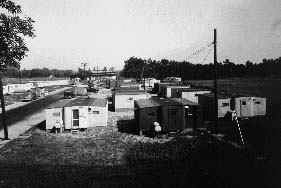
The post-war years saw the general expansion in the number of people living in mobile homes and in the use of mobile homes to house industrial workers. Parks such as Farrington's resembled a fairly typical working class neighborhood, with a mix of young married couples, families with children and more elderly residents. However, specialty parks began to develop in the late 1940s. These parks catered to particular types of tenants, separating old from young, working people from those who had retired, military personnel from civilians, those with children from those without children. These mobile home dwellers and park designers engaged in a peculiar form of voluntary segregation which may have its roots in the large retirement trailer camps of the 1930s that had proved so popular and so profitable.
Many parks, especially the retirement communities, were much more exclusive and expensive. They featured swimming pools, shuffleboard courts, and large lots often with a cabana and carport shelter into which a trailer could be placed.38 These structures not only gave the mobile home additional living space but with the trailers encased in this manner the parks resembled a suburban tract development rather than a trailer park. The park usually also supplied an air-conditioned clubhouse for social and recreational events, which served as a kind of town hall. Some parks also had design guidelines and rules for the upkeep of trailers and grounds. A host of mobile home accessories such as special aluminum awnings, trailer skirts, outdoor privacy panels appeared with which to improve and enhance the appearance of the mobile home. The camaraderie of the campground was giving way to the competition of the suburb.
Such upscale parks were welcomed by the mobile home industry
which recognized that they helped to enhance the image of the
mobile home as a good neighbor and as a desirable housing alternative.
The industry continued to promise, much as it had done in its
early days, the economy, freedom from tedious domestic chores,
and mobility offered by mobile home living. They also offered,
through the new deluxe parks, a sense of security of a homogeneous
population and the companionship of people just like oneself.
In a book published by Trail-R-Club of America, the author exhorts
the reader about the wonders of trailer living and admonishes:
Trailers also became an integral part of large industrial and government projects, especially in the 1950s. The government had purchased an untold number of trailers to house the military and other defense-related personnel during the war. Now they had more trailers than families to fill them. Thousands of surplus government trailers began to appear on university campuses to house veterans and their families taking advantage of the G.I. bill.

Surplus trailers and new modular housing similar to trailers also began to appear on huge public works projects which required thousands of workers in rural areas for a defined period of time. It was determined that conventional housing took too long to build and could not be utilized after the labor force had left. This new-found economy and mobility in managing the workforce had an impact on industry and labor. The mobile home made the logistics of large scale projects such as the Tennessee Valley Authority's dams or the push build atomic weapons plants in the early 1950s, much easier. But the impermanence of the workforce and the housing stock did little to contribute to the infrastructure of the communities in which the projects were built.
Coinciding with the development of the interstate highway system which made transport much easier, manufacturers in the 1960s introduced "double wide" and 'ttriple wide" mobile homes. Each unit was 12 feet wide by 60 feet long and could be shipped separately and bolted together on-site to double or triple the floor space. As the size of the homes expanded, their styling took on more and more features of a suburban ranch house. Applied metal shutters began to appear around windows, which had, but this time, lost the streamlined look. Later innovations included aluminum clapboard siding, coach lamps attached on either side of the door or at the ends of the unit, and pitched roofs. The larger sizes of these new mobile homes also made them less mobile. Once put in places, most of these trailers stayed put. The vestiges of automobile manufacture in mobile homes, the wheels and chassis, were becoming simply a means to get a home to its site and many parks required that they be chastely hidden behind a mobile home "skirt," a type of paneling made to look like a foundation.